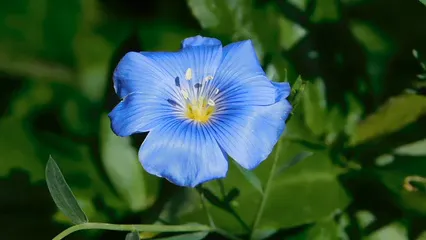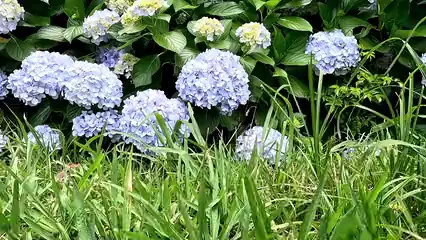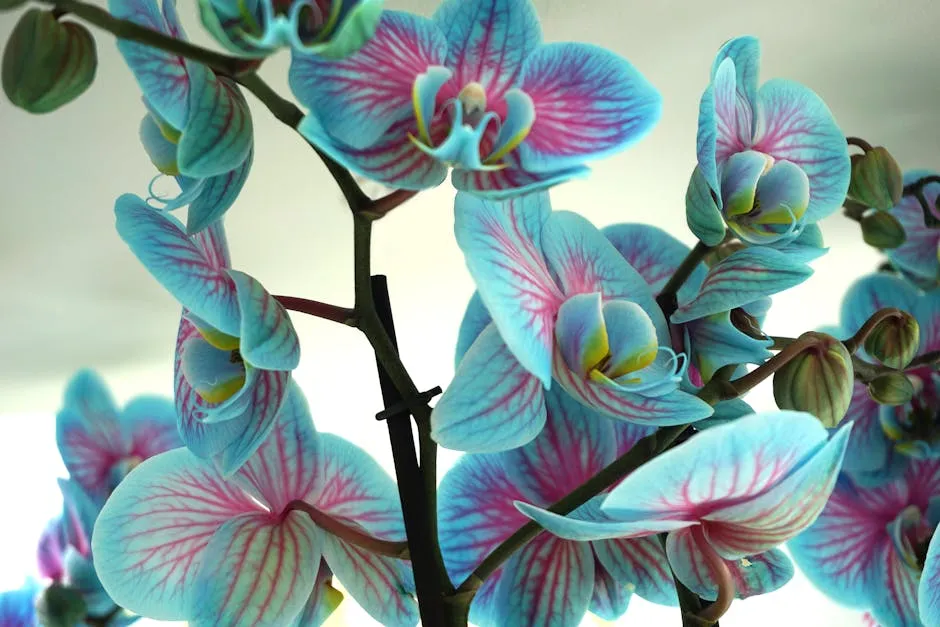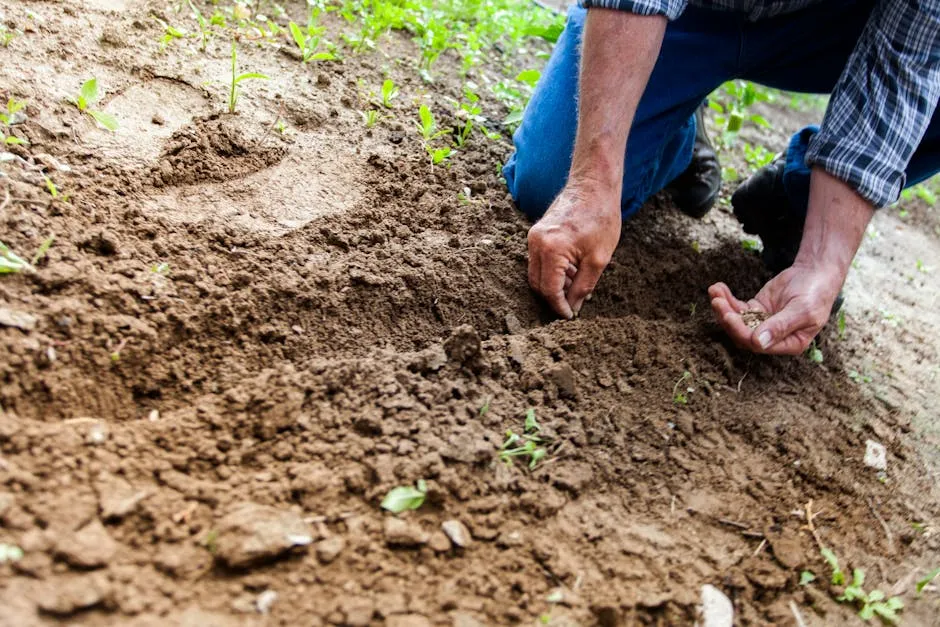
The Allure of Blue Flowers: A Deep Dive into Nature’s Rarest Blooms
Introduction
Blue flowers are often considered the epitome of beauty in the garden, captivating our senses with their vibrant shades that range from sky blue to deep indigo. These rare blooms, making up less than 10% of flowering plants, add an element of uniqueness and serenity to any garden space. They evoke feelings of calmness and tranquility, transforming ordinary landscapes into enchanting havens. But why are blue flowers so scarce? This article will provide insights into their cultivation, significance, and the cultural impact they hold. You may be a seasoned gardener seeking to enhance your landscape or simply someone who appreciates the beauty of nature. Either way, there’s a blue flower calling your name! From the delicate Bluebell to the majestic Hydrangea, these floral wonders have captured the hearts of many. Each type of blue flower has its own charm and requires specific care, making them both a delightful challenge and a rewarding endeavor for gardeners. As we explore this fascinating subject, get ready to uncover tips on how to cultivate these beauties, what conditions they thrive in, and their historical significance in art and culture. You’ll discover why blue flowers are not merely a treat for the eyes but also symbols of deeper meanings and emotions. So, whether you’re looking to plant a calming oasis in your backyard or simply wish to learn more about these captivating blooms, join us on this journey to discover everything you need to know about blue flowers. Prepare to be inspired and perhaps even a little blue-tiful yourself!
The Fascinating World of Blue Flowers
Why Are Blue Flowers Rare?
Blue flowers are a rare spectacle in nature. They comprise less than 10% of all flowering plants. So, what’s the big deal? The biological reasons are fascinating. Most plant pigments are yellow or red. Blue pigments, however, are quite tricky. These hues mainly come from anthocyanins, a group of pigments that can appear blue in certain pH conditions. Anthocyanins change color based on the acidity of the plant’s environment. In highly acidic conditions, they can produce stunning blue shades. This unique characteristic is why many gardeners scramble to create the perfect soil for their blue blooms. Think of it as making a fancy cake; the ingredients must be just right! But the rarity of blue flowers isn’t just about pigments. It’s also an ecological signpost. Blue flowers often attract specific pollinators like bees and butterflies. Their vibrant hues signal a rich nectar source, helping these creatures thrive. In gardens, blue flowers create a visual harmony that draws the eye. They can serve as focal points, adding tranquility to the landscape. They invite both nature and serenity into our outdoor spaces. Imagine strolling through a garden filled with blues. It feels like stepping into a painting. Their scarcity makes each blue flower a treasure. From the delicate Bluebell to the majestic Hydrangea, these flowers are more than just pretty faces; they hold ecological importance and beauty.
Symbolism and Cultural Significance
Blue flowers carry rich symbolism across cultures. Many people associate them with peace, tranquility, and harmony. In various traditions, blue flowers symbolize hope and spiritual awakening. For instance, the Blue Lotus has been revered in many cultures, representing purity and enlightenment. In literature and art, blue flowers have a special place. Vincent Van Gogh famously painted *Irises*, capturing their beauty and depth. His work immortalizes the essence of blue flowers, showcasing their emotional resonance. Artists often use blue flowers to evoke feelings of calmness and introspection, making them a favorite in serene paintings. Moreover, blue flowers find their way into traditional remedies. For centuries, people have used them for their medicinal properties. The Bluebell, for instance, has been said to have soothing effects. In modern times, blue flowers symbolize tranquility and peace, often used in wellness branding. In essence, blue flowers are more than mere decorations. They carry meanings that resonate deeply with people. Whether in gardens, art, or medicine, they remind us of serenity, beauty, and connection to nature. So, the next time you see a blue flower, remember its history and significance. It’s not just a flower; it’s a symbol of peace that transcends cultures and time.Top 20 Blue Flowers for Your Garden
1. Hydrangea
– Description: The Hydrangea is a versatile shrub. It boasts large, mophead flowers in shades of blue. Blooming from midsummer to early fall, it’s a showstopper in any garden. – Care Tips: These beauties thrive in acidic soil. They prefer full sun to partial shade. Keep the soil consistently moist for the best blooms.
2. Cornflower
– Description: Also known as Bachelor’s Buttons, Cornflowers are easy-to-grow annuals. They flaunt vibrant blue blooms, perfect for cutting gardens. – Care Tips: Cornflowers flourish in USDA zones 2 to 11. Full sun and well-drained soil keep them happy and blooming.3. Bluebell
– Description: The Bluebell, with its sweet-smelling bell-shaped flowers, is a charming perennial. These flowers create a lovely woodland look. – Care Tips: They thrive in moist, well-drained soil and partial shade. USDA zones 4 to 8 are ideal for these delicate blooms.4. Dwarf Morning Glory
– Description: This non-vining plant offers charming, delicate blooms. Dwarf Morning Glory is compact yet stunning in blue. – Care Tips: Growing up to 12 inches tall, it prefers full sun and well-drained soil. Water regularly for optimal growth.5. Lobelia
– Description: Lobelia boasts cascading blue flowers, bringing a splash of color to hanging baskets and borders. Its vibrant blooms attract pollinators, making it a garden favorite. – Care Tips: Optimal conditions include full sun to partial shade. Keep the soil moist and well-drained for happy Lobelia.
6. Iris (Bearded Iris)
– Description: Bearded Iris features iconic blue blooms that stand tall and proud. They add elegance and structure to any garden. – Care Tips: They prefer well-drained soil and full sun. Water deeply but infrequently to avoid rot.7. Gentian
– Description: Gentian produces deep blue flowers that thrive in cooler conditions. They are stunning, yet often overlooked. – Care Tips: These flowers prefer gritty, well-drained soil with a pH level around 6.0 to 7.0. They flourish in USDA zones 3 to 7.8. Blue Star
– Description: Blue Star features delicate star-shaped flowers that add a whimsical touch to gardens. These beauties are perfect for borders. – Care Tips: They thrive in average, well-drained soil. Full sun is preferred, making them a fantastic choice for sunny spots.9. Blue Orchid
– Description: The Blue Orchid is an exotic beauty with unique colors. It elevates any indoor space with its striking presence. – Care Tips: These orchids need specific care, including bright indirect light and moist conditions. Ideal for USDA zones 9 to 11.
10. Blue Mist Shrub
– Description: Also known as Caryopteris, this shrub dazzles with showy blue flowers. It attracts butterflies and bees, enhancing your garden’s ecosystem. – Care Tips: It prefers full sun and well-drained soil. Hardy in zones 5 to 9, it requires minimal care once established.11. Love-in-a-Mist
– Description: Love-in-a-Mist features fluffy blue flowers surrounded by fern-like foliage. It’s a charming annual that adds whimsy to any space. – Care Tips: It grows well in full sun or partial shade. Moist, well-drained soil is ideal, thriving in zones 2 to 11.12. Balloon Flower
– Description: Balloon Flowers start as balloon-like buds that open into star-shaped blooms. They add a unique touch to your garden. – Care Tips: They thrive in USDA zones 3 to 8. Full sun to partial shade and loamy soil are key for healthy growth.
13. Blue Daisy
– Description: Blue Daisy, or Felicia, produces cheerful blue blooms with sunny yellow centers. It’s a delightful addition to any garden. – Care Tips: Preferring well-drained soil, these perennials thrive in full sunlight, especially in zones 9 to 15.
14. Blue Flax
– Description: Blue Flax offers delicate, short-lived wildflowers that bloom abundantly in sunny spots. Their gentle beauty catches the eye. – Care Tips: Thriving in USDA zones 4 to 9, they enjoy sunny, well-drained rocky soil.
15. Virginia Bluebells
– Description: Virginia Bluebells are a springtime delight. Their clusters of tubular blue flowers create breathtaking carpets in woodlands. – Care Tips: They thrive in moist, well-drained soil and partial shade. Ideal for USDA zones 3 to 8.
16. Great Lobelia
– Description: Great Lobelia features striking lavender-blue flowers. This perennial is perfect for adding vertical interest to your garden. – Care Tips: It enjoys moist, rich soil and thrives in full sun to partial shade, suitable for zones 4 to 9.
17. Globe Thistle
– Description: Globe Thistle produces unique spherical flowers. They add a whimsical touch and are low-maintenance. – Care Tips: Thriving in well-drained soil, they prefer full sun and are hardy in zones 3 to 8.
18. Bellflower
– Description: Bellflower is known for its lovely blue blooms and bell-shaped flowers. They are perfect for borders and rock gardens. – Care Tips: They prefer well-drained soil and full sun to partial shade. USDA zones 3 to 8 are ideal for these blooms.19. Aster
– Description: Aster offers lovely blue flowers that bloom in late summer. They attract butterflies and provide late-season beauty. – Care Tips: They enjoy full sun and well-drained soil, thriving in zones 3 to 9.20. Bluecrown Passionflower
– Description: This unique vine showcases striking blue flowers. It’s perfect for trellises and fences, adding vertical interest. – Care Tips: Full sun and well-drained, sandy soil are ideal. Hardy in zones 7 to 9, it’s a showstopper in any garden. Adding these stunning blue flowers to your garden can create a visual feast. Each offers unique beauty and charm, enhancing your outdoor space. Happy planting!Best Practices for Growing Blue Flowers
Soil Preparation
Soil is the foundation for thriving blue flowers. The right pH level is crucial. Most blue flowers prefer slightly acidic soil, ideally between 5.5 and 6.5. This acidity helps enhance their vibrant hues. Test your soil with a simple soil pH test kit from your local garden center. Amend your soil as needed. Add organic compost to improve drainage and nutrient content. If your soil is too alkaline, consider adding elemental sulfur or peat moss. Mulching can also help maintain moisture and regulate temperature. A well-draining soil mix is key for blue flowers. Many of them, like the Gentian and Blue Star, enjoy gritty, sandy soils. This helps prevent root rot, which can be a common issue. So, make sure your garden beds are raised or well-drained. Remember, a solid start leads to stunning blooms!
Watering and Maintenance
Watering is essential for blue flowers, but it varies by species. For most, regular watering keeps them happy. Aim for consistent moisture, especially during their active growing season. Watering cans are great for this purpose, giving you that precise control. Bluebell and Lobelia thrive with a deep soak once or twice a week. Avoid overwatering, as this can lead to root rot. Check the top inch of the soil; if it’s dry, it’s time to water. When it rains, skip watering to prevent sogginess. Pest management is crucial too. Aphids and slugs often target blue flowers. Hand-picking is effective for slugs, while insecticidal soap can manage aphids. Regularly check for signs of distress. Yellowing leaves or stunted growth may indicate pest issues. Early detection means healthier plants!Seasonal Care
Understanding seasonal care is vital for successful cultivation. Spring is the best time to plant blue flowers. After the last frost, prepare your garden beds. Remove weeds, and enrich the soil with compost. Summer requires vigilant watering and monitoring for pests. Deadhead your flowers to encourage more blooms. This simple task helps prevent seed formation, extending the flowering period. In fall, it’s time to prepare for winter. For perennials like Bluebell, cut back spent foliage. Mulch around the base to insulate roots against cold temperatures. This protects them during harsh winters. Finally, spring is a time for rejuvenation. Once the frost passes, clean up any debris and check for healthy growth. Your blue flowers will be ready to shine again. With proper care throughout the seasons, you can enjoy a vibrant blue garden year after year.Conclusion
Blue flowers are not just a visual delight; they embody a rich tapestry of history and culture. Each bloom carries stories and meanings that deepen their allure. By grasping their unique needs and characteristics, you can cultivate a garden that thrives, enchants, and invites wildlife. Imagine stepping into your backyard, where vibrant blue petals sway gently in the breeze. It’s like nature painted a serene masterpiece just for you! Whether you’re drawn to blue flowers for their aesthetic appeal or their ecological benefits, they are a worthy addition to any garden. These beauties offer more than mere decoration. They attract bees, butterflies, and other pollinators, making your garden a buzzing hub of life. You’ll find that blue flowers, such as the charming Bluebell or the stately Hydrangea, play a vital role in promoting biodiversity. Moreover, many blue flowers have historical significance, appearing in art and literature. Think of Van Gogh’s *Irises*, which immortalizes their essence. These flowers evoke feelings of calmness and tranquility, creating a peaceful oasis right at home. So, roll up your sleeves and get planting! With the right care, blue flowers will reward you with stunning displays for years to come. They not only brighten your space but also connect you to nature’s wonders. Embrace the journey of growing blue flowers, and you’ll soon discover their enchanting charm woven into your life.FAQs
What are some easy blue flowers for beginners?
For those new to gardening, consider starting with these easy-to-grow blue flowers: Cornflower: Thrives in full sun and well-drained soil. Water regularly for vibrant blooms. Lobelia: Prefers moist soil and partial shade. Ideal for hanging baskets. Dwarf Morning Glory: Non-vining. Requires full sun and well-drained soil.
How do I keep blue flowers blooming?
To ensure your blue flowers continue to bloom, follow these tips: Deadheading: Remove spent flowers to promote new growth. Fertilizing: Use a balanced fertilizer every 4-6 weeks during the growing season. Seasonal care: Adjust watering and care based on seasonal changes, ensuring they get adequate moisture.
Can blue flowers grow in shaded areas?
Yes, some blue flowers thrive in partial shade! Bluebell: Prefers moist, well-drained soil and partial shade. Lobelia: Does well in shaded areas, making it perfect for hanging baskets or borders.
What pests are common in blue flowers, and how can I manage them?
Common pests include: Aphids: Treat with insecticidal soap or neem oil. Slugs: Hand-picking or using diatomaceous earth can help control them. Regularly inspect for signs of distress to manage pests early.
Are there blue flowers that attract butterflies?
Absolutely! Blue flowers are known for attracting butterflies and other pollinators. Some favorites include: Lobelia: Its vibrant blooms draw butterflies. Blue Mist Shrub: A magnet for pollinators. Cornflower: Loved by bees and butterflies alike. Plant these beauties and watch your garden come alive!
If you’re interested in enhancing your gardening skills and creating beautiful spaces, check out our guide on DIY vertical gardening ideas for apartments.
All images from Pexels



